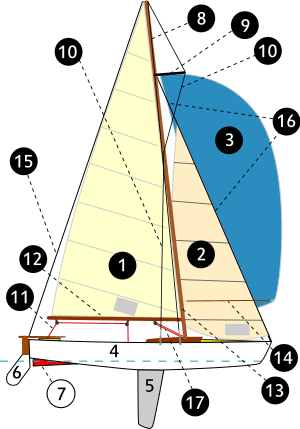Boom vang

A boom vang (US) or kicking strap (UK) is a line or piston system on a sailboat used to exert downward force on the boom and thus control the shape of the sail. The Collins English Dictionary defines it as "A rope or tackle extended from the boom of a fore-and-aft mainsail to a deck fitting of a vessel when running, in order to keep the boom from riding up".[1]
The vang typically runs from the base of the mast to a point about a third of the way out the boom. Due to the great force necessary to change the height of the boom while a boat is under sail, a line-based boom vang usually includes some sort of a pulley system. Hydraulic piston vangs are used on larger sailboats and controlled by manual or electric hydraulic pumps.
The term kicking strap is normally shortened to "kicker" whilst sailing, e.g. "Hard on the kicker when we get to the leeward mark".
On some sailing boats, such as the 49er, rather than a set of lines pulling the boom downwards, a rigid member is used to push the boom down. By controlling leech tension, the boom vang is one of the three methods of controlling sail twist.
On small sailboats and some cruising sailboats a vang may be omitted. If a vang is not installed, then the sheet has to try to control both horizontal and vertical angles of the boom. When the boom is near the centerline, the sheet is nearly vertical, and can exert downward force on the boom. As the sheet is loosened to increase the horizontal angle of the boom and sail, the sheet becomes horizontal and exerts less downward force. A vang works with the sheet to apply the downward force on the boom at all horizontal angles, allowing the sheet to be used to control the horizontal angle of the boom effectively.
While under sail, the opposite force to the vang is supplied by the sail itself. When the sail is furled, a topping lift supplies the upward force on the boom. Some line vang systems incorporate a piston to provide the topping lift force and to damp oscillations. Hydraulic vangs can inherently act in the topping lift role.
A gnav (the word vang spelt backwards) is an inverted vang. It is a rigid strut that extends obliquely upward from the boom to the mast, exerting a force that pushes down on the boom. As the fixing point of the gnav on the boom is hauled inwards towards the mast, the downward force on the boom increases. A gnav offers more uncluttered space beneath the boom when compared to a vang.
References
- ↑ vang. Collins English Dictionary - Complete & Unabridged 11th Edition. HarperCollins Publishers. http://www.collinsdictionary.com/dictionary/english/vang (accessed: July 20, 2012).
